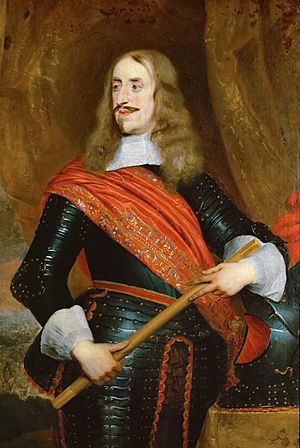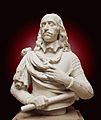Archduke Leopold Wilhelm of Austria facts for kids
Quick facts for kids
Archduke Leopold Wilhelm of Austria
|
|
|---|---|

Archduke Leopold Wilhelm of Austria, by Pieter Thijs
|
|
| Born | 5 January 1614 Wiener Neustadt |
| Died | 20 November 1662 (aged 48) Vienna |
| Allegiance | |
| Years of service | 1640 to 1656 |
| Commands held | Governor, Spanish Netherlands 1647-1656 |
| Battles/wars | Thirty Years' War Second Breitenfeld Franco-Spanish War (1635–1659) Gravelines Lens |
| Relations | Emperor Ferdinand III brother Leopold I nephew |
| Other work | Prince-bishop Halberstadt Passau Breslau Olmütz Strasbourg Grand Master, Teutonic Order 1641–1662 |
Archduke Leopold Wilhelm of Austria (born January 5, 1614 – died November 20, 1662) was an important figure in Austrian history. He was the younger brother of Emperor Ferdinand III. Leopold Wilhelm was a soldier, a leader, and a big supporter of the arts.
He led armies in several battles, though not always with great success. He also served as the Governor of the Spanish Netherlands. After this, he returned to Vienna in 1656. Even though he was considered to become the next Holy Roman Emperor after his brother Ferdinand died in 1657, he chose to step aside. Instead, his nephew Leopold I became the new Emperor.
Leopold Wilhelm's biggest passion was art. He supported many famous artists of his time. His amazing collection of 17th-century paintings from Venice and the Netherlands is now kept at the Kunsthistorisches Museum in Vienna.
Life Story

Leopold Wilhelm was born in Wiener Neustadt on January 5, 1614. He was the sixth of seven children. His parents were Emperor Ferdinand II and his first wife, Maria Anna of Bavaria. His older brother, Ferdinand III, later became the Holy Roman Emperor.
His Career
Since he was a younger son, Leopold was prepared for a life in the church. However, he never actually became a priest. Even so, he held several important church positions. These were called Prince-Bishoprics and they gave him an income. Some of these included Halberstadt, Passau, Breslau, Olmütz, and Strasbourg.
He also became the Grand Master of the Teutonic Order in 1641. This was a powerful religious and military group.
During his lifetime, the Habsburg rulers faced many wars. These included the Dutch Revolt and the Thirty Years War. There was also the Franco-Spanish War (1635–1659). Even though Leopold Wilhelm was not eager to be a military leader, his brother Ferdinand made him an Imperial commander in 1639. This was because there weren't many other good leaders available.
He stepped down after a big loss at the Second Breitenfeld in 1642. He had fought this battle even though his generals advised against it. He was given command again after another defeat in 1645. Then, in 1647, he became the Governor of the Spanish Netherlands. In this role, he lost the Battle of Lens. He then helped to end the Thirty Years' War with the Treaty of Westphalia in 1648. However, the war between France and Spain continued, so he had to stay in Brussels until 1656.
His Art Collection
While he was in Brussels, Leopold Wilhelm hired David Teniers the Younger to manage his art collection. He spent huge amounts of money buying artworks. He collected pieces by artists like Frans Snyders, Peter Snayers, Daniel Seghers, and Pieter Thijs. He also bought many Italian masterpieces. These came from the collections of Bartolomeo della Nave and King Charles I.
His most treasured artworks were shown in a book called Theatrum Pictorium. This book is often called the first "art catalogue." In 1653, the tomb of Childeric I, an old Merovingian king, was found. Leopold Wilhelm made sure this discovery was written about and shared.
When he returned to Vienna in 1656, his art collection moved to the Hofburg Palace. A Flemish priest and artist named Jan Anton van der Baren became its director. Leopold Wilhelm left his collection to his nephew, Leopold I. Today, these artworks are a major part of the Kunsthistorisches Museum in Vienna.
Leopold Wilhelm was also active in the politics of the royal court. He was close to his stepmother, Eleonora of Mantua. They both loved Italian art and supported the Counter-Reformation, which was a movement to strengthen the Catholic Church. Even though he was suggested as a possible Holy Roman Emperor in 1657, he made sure his nephew Leopold I was chosen instead. This happened when Leopold I turned 18 in July 1658.
Images for kids
-
Bust of Archduke Leopold Wilhelm of Austria, by Francois Dieussart (1656). Kunsthistorisches Museum
See also
 In Spanish: Leopoldo Guillermo de Habsburgo para niños
In Spanish: Leopoldo Guillermo de Habsburgo para niños



